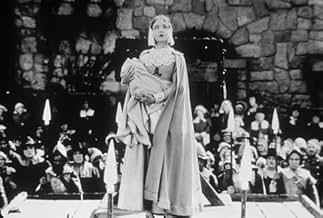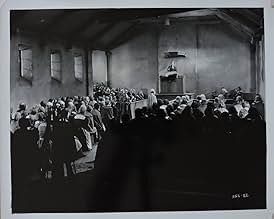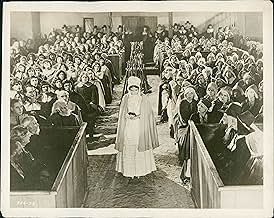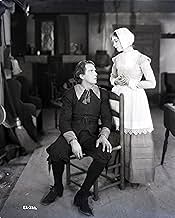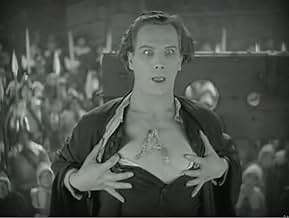AVALIAÇÃO DA IMDb
7,6/10
2,1 mil
SUA AVALIAÇÃO
Adicionar um enredo no seu idiomaAfter having a baby out of wedlock, a young Puritan woman is pressured to reveal the name of her lover.After having a baby out of wedlock, a young Puritan woman is pressured to reveal the name of her lover.After having a baby out of wedlock, a young Puritan woman is pressured to reveal the name of her lover.
- Direção
- Roteiristas
- Artistas
- Prêmios
- 1 vitória no total
Buck Black
- Child in crowd
- (não creditado)
Nora Cecil
- Townswoman
- (não creditado)
Iron Eyes Cody
- Young Indian at Dunking
- (não creditado)
Artye Folz
- Child
- (não creditado)
Dorothy Gray
- Child
- (não creditado)
Douglas Haig
- Minor Role
- (não creditado)
Betsy Ann Hisle
- Child
- (não creditado)
Avaliações em destaque
10Doug-193
Exactly what we've lost since the end of the silent era is magnificently on display in Victor Seastrom's THE SCARLET LETTER: shimmering black and white photography of superbly composed and paced scenes capturing the essence of the American classic novel by Hawthorne, though certain details of the story have been altered and may annoy literary purists. This is not the novel but a separate work, more than a perceptive and intelligent picturization. Here is the great, lost art of silent screen acting, with Lillian Gish, unforgettable as Hesther Prynne, leading an accomplished cast. The result is pure visual poetry.
Victor Seastrom's magnificent retelling of Hawthorne's important novel is beautifully directed with an incredible performance by Lillian Gish. It is a disgrace that this film is not available in either VHS or DVD format (and especially so since the ludicrous version with Demi Moore is).
Victor Sjöström's The Scarlet Letter is a masterpiece. It should be put on DVD for all to enjoy, even if parts of the film have to be supplemented with 16mm dupes. TCM hasn't shown it in years, yet they show The Wind several times every year. It makes no sense. The Scarlet Letter is even better than The Wind. It should be shown in high school classes along with the required reading of the classic novel by Nathanial Hawthorne. It makes my head spin to think of how many thousands of children would fall in love with silent film if they were only exposed to this classic. I hate to think of them being exposed to that horrific Demi Moore version instead.
Lillian Gish is radiantly beautiful as the demure but sensual Hester Prynne. Lars Hanson makes an exceptionally wonderful minister Dimmesdale, fighting his romantic feelings for the lovely Hester. Henry B. Walthall makes a very believable and threatening Roger Prynne. Karl Dane adds some wonderful comic relief as Master Giles. The M-G-M production values here are exceptional and the cinematography by Henrik Sartov glows. I love the tracking shots of Hester and the Reverend Arthur Dimmesdale walking together in the woods, and the lovely shot of their reflections in the lake as they confess their love for one another. Poetry on screen. The musical score for the film is quite beautiful, commissioned by TCM in 2000. The only parts that got on my nerves were the harpsichord sections. The flute, piano and violin parts were the best.
Your silent film viewing is not complete without seeing this classic. It's Lillian Gish's best film. Don't miss it.
Lillian Gish is radiantly beautiful as the demure but sensual Hester Prynne. Lars Hanson makes an exceptionally wonderful minister Dimmesdale, fighting his romantic feelings for the lovely Hester. Henry B. Walthall makes a very believable and threatening Roger Prynne. Karl Dane adds some wonderful comic relief as Master Giles. The M-G-M production values here are exceptional and the cinematography by Henrik Sartov glows. I love the tracking shots of Hester and the Reverend Arthur Dimmesdale walking together in the woods, and the lovely shot of their reflections in the lake as they confess their love for one another. Poetry on screen. The musical score for the film is quite beautiful, commissioned by TCM in 2000. The only parts that got on my nerves were the harpsichord sections. The flute, piano and violin parts were the best.
Your silent film viewing is not complete without seeing this classic. It's Lillian Gish's best film. Don't miss it.
There just aren't enough words to describe the beautiful performances in this film....not that words are needed, then or now. Victor Seastrom's lovingly crafted scenes provide perfect visual frames for the transcendent performances of Lillian Gish and Lars Hanson. An artistic triumph for everyone concerned, and a bittersweet reminder of what was lost with the death of the art of the silent film. (The Turner restoration is alas, also bittersweet, as prints of wildly differing quality had to be "married" in order to create a substantially complete copy of the subject. Thus, viewers move from scenes that shimmer with pristine beauty to muddy, contrasty dupes. It's a tribute to the art of all concerned however, that this is not the distracting issue it might be with a lesser film. Like any work of art, you won't notice the cracks and flaws after a while if you're paying attention as you should. It's just a shame that the entire film isn't as mint-fresh as some of its scenes.)
It was a novel Hollywood didn't want to touch in the mid-1920s, even though the 1850 classic was brought to the screen six times earlier. The recently-established Will Hays office had its censorship fangs out. A story about a married woman who gets pregnant by a lover was cause for alarm for most movie studios.
Lilian Gish, one of silent film's major star, had long wanted to bring Nathaniel Hawthorne's 'The Scarlet Letter' in an updated version to the screen. Contracted to MGM in a three-picture deal, she convinced the studio's head of production, Irving Thalberg, she could deliver a tasteful version of Hawthorne's book without moralistic tongue-waggers complaining. With a script by Frances Marion, which follows the novel closely, MGM's August 1926's "The Scarlet Letter" has been praised as the best version of the book in a long-line of past and future movie adaptations.
Its success can be attributed to Gish herself, who portrays Hester Prynne. She hasn't heard from her husband who traveled overseas for several years from their Puritan Boston, Massachusetts, home in the mid-1600s. She becomes pregnant from a man whom she doesn't disclose the name. The Gish version departs from Hawthorne in a couple of major ways: the film begins a year earlier than the author's, showing her condemned to a stockade for leaping and dancing after her song bird escapes its cage. It's there where she meets the Reverend Arthur Dimmesdale (Lars Hanson). Also, the films unveils the love relationship between the minister and Hester, not keeping secret of who's the father of the baby.
Another reason for the movie's overall financial popularity is Swedish director Victor Sjostrom's unique directing. He allowed Gish the freedom to display her attractiveness by literally letting her hair down in a clandestine meeting with Dimmesdale in the woods, reflecting Hester's modernistic independence. Gish had the choice in selecting the director, and she picked Sjostrom because she "felt the Swedes were closer to the feelings of New England Puritans than modern Americans." She also favored Hanson as Dimmesdale from his 1924 performance in "The Saga of Gosta Berling." Hanson, who knew very little English, elected to speak his lines (it was a silent movie after all) in Swedish while Gish spoke English in scenes where they're together. Homesick actress Greta Garbo, recently arriving in America from Sweden after signing a contract with MGM, was a near daily presence on the set since she was comfortable speaking her native language with Hanson.
With two weeks of filming to go, Lillian found out her mother suffered a stroke in London and reportedly dying. Dorothy, her sister, urged her to catch the first boat to England to attend to her. In a near impossible request, Lillian asked Sjostrom she needed to leave in three days to travel by train to New York City, then on to a liner to London. The director didn't flitch. He designed an almost around-the-clock schedule to film all of Gish's parts-as long as the crew agreed to the grueling sleepless itinerary. The workers heartedly agreed.
"The Scarlet Letter" is still admired for Sjostrom's creation of an environmental rise en scene that underscored the film's characters' emotion and psychology by its pastoral recreation of a 17th century village. Even though the residents of Salem, MA, where the story takes place, were insulted by their forefathers' portrayal in the film, the American Film Institute nominated it as one of the most passionate motion pictures ever made as well as nominated Hester Prynne as one of movie's most admired heroes.
Lilian Gish, one of silent film's major star, had long wanted to bring Nathaniel Hawthorne's 'The Scarlet Letter' in an updated version to the screen. Contracted to MGM in a three-picture deal, she convinced the studio's head of production, Irving Thalberg, she could deliver a tasteful version of Hawthorne's book without moralistic tongue-waggers complaining. With a script by Frances Marion, which follows the novel closely, MGM's August 1926's "The Scarlet Letter" has been praised as the best version of the book in a long-line of past and future movie adaptations.
Its success can be attributed to Gish herself, who portrays Hester Prynne. She hasn't heard from her husband who traveled overseas for several years from their Puritan Boston, Massachusetts, home in the mid-1600s. She becomes pregnant from a man whom she doesn't disclose the name. The Gish version departs from Hawthorne in a couple of major ways: the film begins a year earlier than the author's, showing her condemned to a stockade for leaping and dancing after her song bird escapes its cage. It's there where she meets the Reverend Arthur Dimmesdale (Lars Hanson). Also, the films unveils the love relationship between the minister and Hester, not keeping secret of who's the father of the baby.
Another reason for the movie's overall financial popularity is Swedish director Victor Sjostrom's unique directing. He allowed Gish the freedom to display her attractiveness by literally letting her hair down in a clandestine meeting with Dimmesdale in the woods, reflecting Hester's modernistic independence. Gish had the choice in selecting the director, and she picked Sjostrom because she "felt the Swedes were closer to the feelings of New England Puritans than modern Americans." She also favored Hanson as Dimmesdale from his 1924 performance in "The Saga of Gosta Berling." Hanson, who knew very little English, elected to speak his lines (it was a silent movie after all) in Swedish while Gish spoke English in scenes where they're together. Homesick actress Greta Garbo, recently arriving in America from Sweden after signing a contract with MGM, was a near daily presence on the set since she was comfortable speaking her native language with Hanson.
With two weeks of filming to go, Lillian found out her mother suffered a stroke in London and reportedly dying. Dorothy, her sister, urged her to catch the first boat to England to attend to her. In a near impossible request, Lillian asked Sjostrom she needed to leave in three days to travel by train to New York City, then on to a liner to London. The director didn't flitch. He designed an almost around-the-clock schedule to film all of Gish's parts-as long as the crew agreed to the grueling sleepless itinerary. The workers heartedly agreed.
"The Scarlet Letter" is still admired for Sjostrom's creation of an environmental rise en scene that underscored the film's characters' emotion and psychology by its pastoral recreation of a 17th century village. Even though the residents of Salem, MA, where the story takes place, were insulted by their forefathers' portrayal in the film, the American Film Institute nominated it as one of the most passionate motion pictures ever made as well as nominated Hester Prynne as one of movie's most admired heroes.
Você sabia?
- CuriosidadesLillian Gish learned that her mother had had a stroke in London and her sister, Dorothy Gish, urged her to get there on the first available boat. When Lillian informed director Victor Sjöström of the need to finish the film quickly, he created a shooting schedule that crammed two weeks worth of shooting into three days of non-stop work. The crew worked without complaint so that she could finish the film early and catch the earliest possible train to New York.
- Citações
Mistress Hibbins: I am wrongly accused! Never hath my tongue been given to gossip!
The Governor: Falsehood! Her tongue hath wagged like the tail of a dog! Duck her again!
- Versões alternativasIn 2000, Turner Entertainment Co. copyrighted a restored version with a musical score written by Lisa Catarineau and Mark Northam and a running time of 98 minutes. Its previous version ran 79 minutes.
- ConexõesFeatured in The 43rd Annual Academy Awards (1971)
Principais escolhas
Faça login para avaliar e ver a lista de recomendações personalizadas
- How long is The Scarlet Letter?Fornecido pela Alexa
Detalhes
- Data de lançamento
- País de origem
- Central de atendimento oficial
- Idioma
- Também conhecido como
- The Scarlet Letter
- Locações de filme
- Empresa de produção
- Consulte mais créditos da empresa na IMDbPro
Bilheteria
- Orçamento
- US$ 430.290 (estimativa)
- Tempo de duração
- 1 h 55 min(115 min)
- Mixagem de som
- Proporção
- 1.33 : 1
Contribua para esta página
Sugerir uma alteração ou adicionar conteúdo ausente

